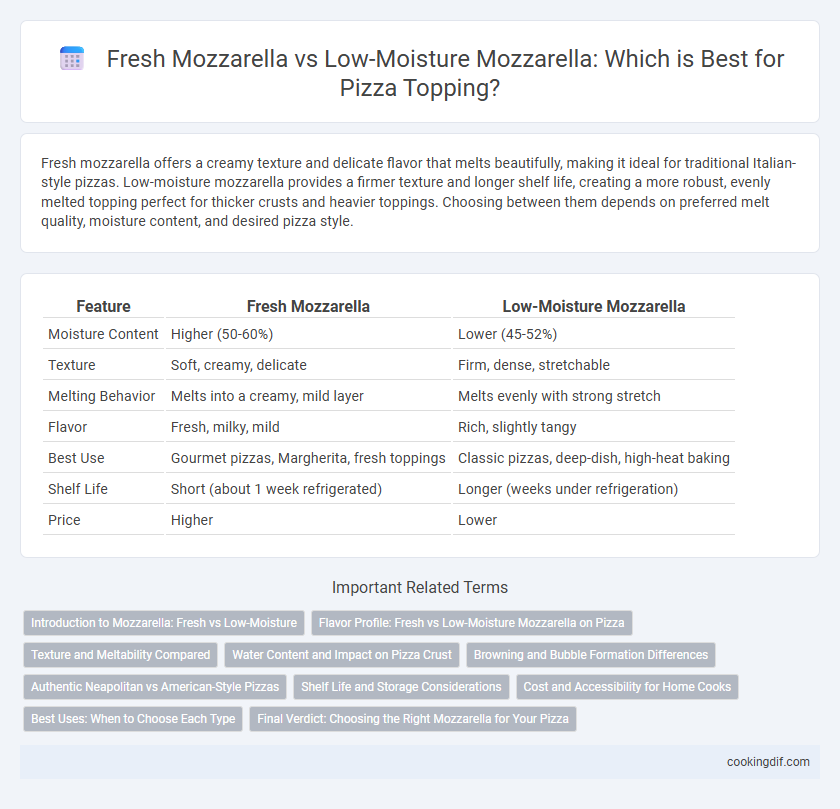Fresh mozzarella offers a creamy texture and delicate flavor that melts beautifully, making it ideal for traditional Italian-style pizzas. Low-moisture mozzarella provides a firmer texture and longer shelf life, creating a more robust, evenly melted topping perfect for thicker crusts and heavier toppings. Choosing between them depends on preferred melt quality, moisture content, and desired pizza style.
Table of Comparison
| Feature | Fresh Mozzarella | Low-Moisture Mozzarella |
|---|---|---|
| Moisture Content | Higher (50-60%) | Lower (45-52%) |
| Texture | Soft, creamy, delicate | Firm, dense, stretchable |
| Melting Behavior | Melts into a creamy, mild layer | Melts evenly with strong stretch |
| Flavor | Fresh, milky, mild | Rich, slightly tangy |
| Best Use | Gourmet pizzas, Margherita, fresh toppings | Classic pizzas, deep-dish, high-heat baking |
| Shelf Life | Short (about 1 week refrigerated) | Longer (weeks under refrigeration) |
| Price | Higher | Lower |
Introduction to Mozzarella: Fresh vs Low-Moisture
Fresh mozzarella offers a creamy texture and milky flavor due to its high moisture content, making it ideal for Neapolitan-style pizzas with a soft, chewy crust. Low-moisture mozzarella contains less water, providing a firmer texture and better melting properties, which results in a golden, stretchy cheese topping perfect for New York-style pizzas. Choosing between fresh and low-moisture mozzarella impacts pizza flavor, texture, and meltability, influencing the overall baking experience and final taste.
Flavor Profile: Fresh vs Low-Moisture Mozzarella on Pizza
Fresh mozzarella offers a delicate, milky flavor with a soft, creamy texture that melts evenly, creating a fresh and light topping on pizza. Low-moisture mozzarella has a more concentrated, tangy taste with a firmer texture that browns and stretches well, delivering a classic, robust cheese experience. Choosing between the two depends on whether a pizza calls for a subtle creaminess or a bold, chewy melt.
Texture and Meltability Compared
Fresh mozzarella offers a soft, creamy texture with high moisture content, resulting in a smooth, gooey melt that creates a rich, elastic cheese topping on pizza. Low-moisture mozzarella has a firmer, denser texture and melts evenly into a stretchy, slightly chewy consistency, providing better browning and longer shelf life. Choosing between fresh and low-moisture mozzarella impacts pizza texture and meltability, influencing overall taste and appearance.
Water Content and Impact on Pizza Crust
Fresh mozzarella contains higher water content, typically around 50-60%, resulting in a creamier texture but a wetter pizza crust that can become soggy. Low-moisture mozzarella, with moisture levels around 45% or less, melts smoothly while promoting a crispier crust by reducing excess moisture release during baking. Choosing between these cheeses significantly influences the crust's texture and overall pizza quality.
Browning and Bubble Formation Differences
Fresh mozzarella contains higher moisture content, resulting in a creamier texture but less browning and fewer bubbles during baking. Low-moisture mozzarella, with reduced water content, promotes more pronounced browning and larger bubble formation, creating a crispier, more visually appealing cheese topping. Chefs often choose low-moisture mozzarella for pizzas that require a golden crust and bubbly cheese surface.
Authentic Neapolitan vs American-Style Pizzas
Fresh mozzarella, with its high moisture content and creamy texture, is the traditional choice for Authentic Neapolitan pizzas, providing a delicate melt and subtle milky flavor that complements the thin crust. Low-moisture mozzarella, preferred in American-style pizzas, offers a firmer texture and longer shelf life, delivering a stretchy, gooey melt that holds up well to heavier toppings and thicker dough. Understanding these differences helps in choosing the right cheese to achieve the desired flavor profile and texture for each pizza style.
Shelf Life and Storage Considerations
Fresh mozzarella features a higher moisture content, resulting in a shorter shelf life of about 5 to 7 days when refrigerated, and it requires airtight storage to prevent spoilage. Low-moisture mozzarella has reduced water content, extending its refrigerated shelf life up to several weeks and enabling more flexible storage conditions like vacuum-sealing. Choosing between the two depends on balancing freshness preferences with the practicality of longer shelf life and ease of storage.
Cost and Accessibility for Home Cooks
Fresh mozzarella offers a creamy texture and authentic taste but tends to be more expensive and perishable, making it less accessible for home cooks on a budget. Low-moisture mozzarella is widely available, cost-effective, and has a longer shelf life, providing a convenient option for frequent pizza making. Choosing between the two depends on balancing flavor preferences with cost and storage considerations.
Best Uses: When to Choose Each Type
Fresh mozzarella offers a creamy texture and mild flavor, making it ideal for Neapolitan-style pizzas and dishes where a soft, melting consistency is desired. Low-moisture mozzarella provides a firmer texture with less water content, perfect for New York-style pizzas or recipes requiring longer baking times and a more pronounced cheesy stretch. Choosing between fresh and low-moisture mozzarella depends on the desired melting quality, moisture level, and pizza style.
Final Verdict: Choosing the Right Mozzarella for Your Pizza
Fresh mozzarella delivers a creamy texture and rich, milky flavor that melts beautifully, ideal for Neapolitan and artisan-style pizzas. Low-moisture mozzarella offers a firmer consistency and longer shelf life, producing a golden, stretchy cheese melt favored in American-style pizzas. Selecting the right mozzarella depends on desired texture, flavor intensity, and baking time to achieve the perfect pizza topping harmony.
Fresh mozzarella vs low-moisture mozzarella for cheese topping Infographic

 cookingdif.com
cookingdif.com